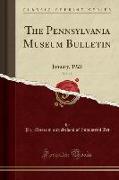- Start
- The Pennsylvania Museum Bulletin, Vol. 18
The Pennsylvania Museum Bulletin, Vol. 18
Angebote / Angebote:
Excerpt from The Pennsylvania Museum Bulletin, Vol. 18: January, 1923It is not without purpose that so far we have deferred discussing the age of this bronze. It is a problem that presents insuperable barriers to the western critic, and no trustworthy solution can ever be reached until students of the subject in India turn seriously to search for evidence which can end the large amount of meaningless speculation on the subject. The publication in Rupam of the recent discovery of a dated bronze Nataraj a is a step in the right direction, certainly it should silence those who would have us believe that images such as these date as far back as the eighth or ninth cen tuties, for in spite of its apparent antiquity, judged by the patina the metal had acquired and the comparative simplicity of the modelling, it proves to be inscribed with the date 4611 (1511 A. D.) In part this revelation is but additional proof that appearances of age, in bronzes especially, are no safe guide to accurate dating, in truth the sorry fact that by the application of chemicals and skillful treatment any patina may today be imitated has made us unwary already of depend ing upon that indication alone. It might be said that the Museum's Nataraja is not so old as the one found dated 1511, if we argue that it seems slightly more sophisticated in treatment, a belief to which the sharper form of the features, the more refined turning of the limbs, and the restrained pose of the head and neck all might be said to testify. On the other hand it cannot be denied that a far-earlier sculptor with a readier hand but more restraint might have produced our example in the fifteenth century. And so the matter stands, nor can we hope to get nearer the truth until a close study, technical as well as esthetic, is made of the early Natarajas and similar metal figures in India, a far from uninteresting research and one to be earnestly encouraged.Fortunately uncertainty of date does not trouble our artistic ap preciation of the Nataraja, mere years cannot rob the statue of its imperishable youthfulness in our eyes, and the lithe virility it por trays is unalterably appealing. Though twenty centuries of closely traditional thought have made our western minds purblind to almost all religious symbols save those whose aspects are benignant calm or majestic suffering, yet still we may grasp the happy meaning of the Nataraja - the dance of the all-pervading spirit of the universe that is the rapture, the ecstasy of creation.About the PublisherForgotten Books publishes hundreds of thousands of rare and classic books. Find more at www.forgottenbooks.comThis book is a reproduction of an important historical work. Forgotten Books uses state-of-the-art technology to digitally reconstruct the work, preserving the original format whilst repairing imperfections present in the aged copy. In rare cases, an imperfection in the original, such as a blemish or missing page, may be replicated in our edition. We do, however, repair the vast majority of imperfections successfully, any imperfections that remain are intentionally left to preserve the state of such historical works.
Folgt in ca. 5 Arbeitstagen
